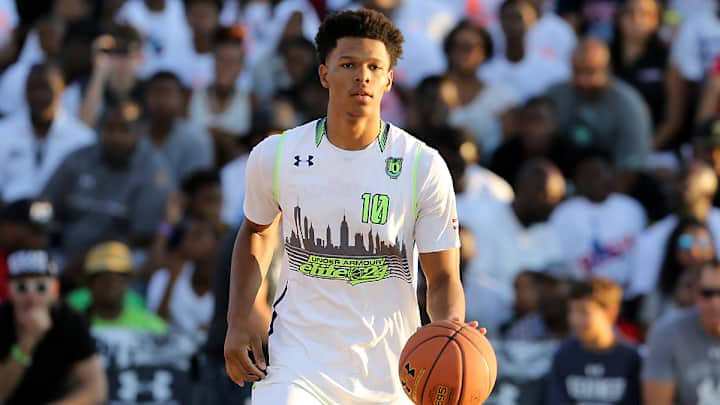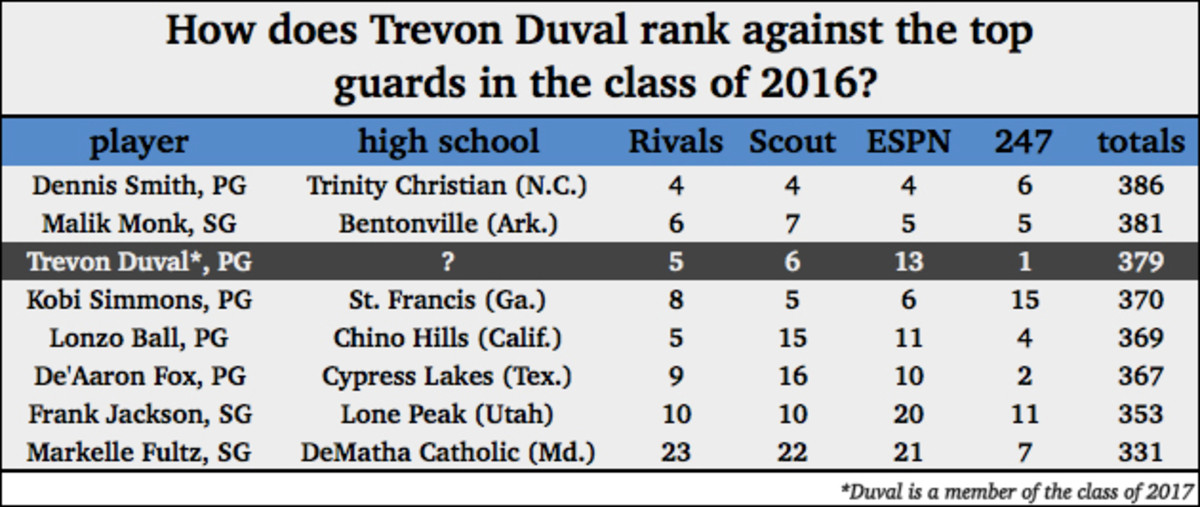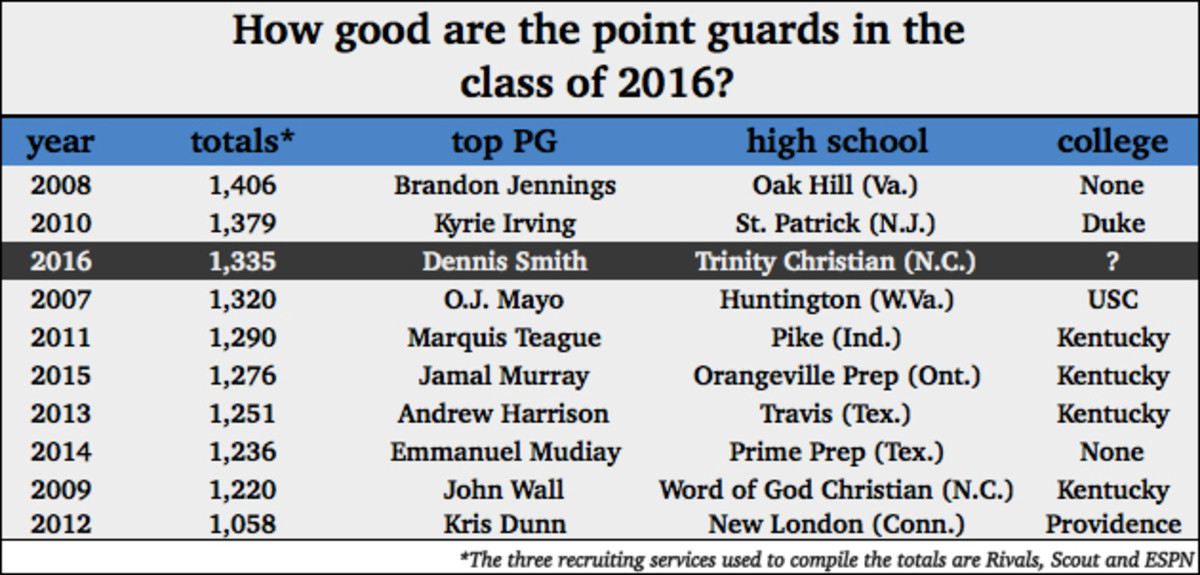Trevon Duval could be the best point guard prospect in high school

BROOKLYN, N.Y. — Pier 2 here attracts locals with an array of playing surfaces. There’s a rink for roller-skating, courts for handball and a plot of artificial turf for other sports. But this weekend, the pier was overrun by one sport. Under Armour, hosting its prestigious Elite 24 competition, decided to stick its emblem in so many places that it would have been difficult for anyone passing through the area not to wonder what was going on. One of two company logos—the signature double parabola or the green-and-turquoise E24 design—was plastered everywhere, from the players’ uniforms to center court to the T-shirts of the members of the drum line assembled for live entertainment. In many ways, the Elite 24 is less a basketball event than an ambitious demonstration of corporate excess, a bigger #brand play than 75 percent of Darren Rovell’s tweets.
But from a basketball perspective, there were high expectations for the 10th edition of Under Armour's marquee showcase. The recruiting class of 2016, the primary group of players from which UA drew to fill out its team “DOO BE DOO” and “EZ PASS” rosters, is among the best in recent memory. Power forward Harry Giles, arguably the top player in the class, has drawn comparisons to Chris Webber. Josh Jackson is the best shooting guard prospect one prominent scout has ever evaluated. In all likelihood, Duke commit Jayson Tatum will use his breathtakingly smooth offensive game to dominate the ACC for a season before becoming a top-five draft pick. Yet the defining characteristic of this class—an abundance of top-flight point guards—involves none of those players.
From Trinity Christian (N.C.) High’s Dennis Smith Jr. to Chino Hills (Calif.) High’s Lonzo Ball to Cypress Lakes (Texas) High’s De’Aaron Fox and St. Francis (Ga.) School’s Kobi Simmons, there are a handful of point guards who could thrive during brief stints in college and then make seamless transitions to the NBA. The group grows if you expand your view of what constitutes a PG—Malik Monk, Frank Jackson and even Markelle Fultz could play that position in college. But with Smith recovering from a torn ACL in his left knee and Fox foregoing the Elite 24 for a Nike trip to the Bahamas, one player from the class of 2017 took advantage of the Elite 24 to further his case as the best floor general in high school.
As a member of the class of 2017, Trevon Duval was young compared to most of his teammates here this weekend, but he’s grown accustomed to facing older players. Duval’s father, Trevor, said that Trevon played with older kids throughout his childhood. He developed sharp ball-handling skills by dribbling around furniture in his home and incorporating what he saw from the basketball movies his father showed him, including Soul in the Hole and He Got Game; Duval also enjoyed watching the And 1 Mixtape Tour. “That’s probably where some of my dribbling came from, too,” Duval says. “Just watching guys do all types of tricks and be creative with their handle.”
Duval was born in Queens, N.Y. and went to middle school in Delaware before enrolling at Saint Benedict’s Preparatory School for high school. The elder Duval said Trevon left Delaware for the Newark, N.J. school in large part because of the exposure and high level of competition it offered. When Gray Bees coach Mark Taylor first saw Duval play the summer before his freshman year, he said he thought Duval was “a little raw” while acknowledging that he was impressed with his athleticism. Duval showed promise as a freshman but the team featured an established senior point guard, Jonathan Williams, a former three-star recruit who now plays for Virginia Commonwealth. That summer, Duval joined a more highly touted backcourt player, Kentucky five-star signee Isaiah Briscoe, on the New Jersey-based Playaz Basketball Club. Briscoe averaged team highs in points and assists in leading the Playaz to a Peach Jam title, while Duval served as a complementary playmaker on the perimeter.
Duval began garnering attention from major scouting services even before that season with the Playaz, but a strong sophomore year at Saint Benedict’s and a 2015 travel campaign in which he took on a bigger role with a different team cemented him as one of the nation’s top guards. Duval said he left the Playaz to join WeR1—which attracts players from Philadelphia, Delaware and New Jersey—because it was closer to home. Duval’s father is an assistant coach for WeR1, and Duval played for the program when he was in middle school. He performed well from the start, averaging more than 17 points and four assists over 16 games and serving as one half of an imposing backcourt tandem with Quade Green, a four-star guard from Philadelphia. “We just put everything together, we learn stuff from each other,” Green says. The moment that defined Duval’s summer came at the Under Armour Finals in July. In a game against Detroit-based 1Nation and Josh Jackson, Rivals.com’s top player in the class of 2016, Duval scored 24 points on 50% shooting, recorded three steals and dropped in a game-winning layup. Afterward, scout Jerry Meyer suggested that Duval “might just be the best overall prospect in the class.”
It’s too early to bestow that distinction upon Duval or anyone else; there will be movement atop the class of 2017 next summer as players compete against one another with their grassroots teams. In the meantime, we can assess Duval’s standing against the other point guards in high school. At 6’3” and 185 pounds, Duval is a skilled ball-handler with a fast first step and, according to WeR1 director Terrell Myers, an uncannily quick “reaction to plays.” He’s so explosive that he can blow past most defenders without shaking them with a dribble or body feint, but the control he exerts over the ball in tight quarters separates him from other players at his position. During a scrimmage at a practice on Friday, he drove into a corner, froze his mark with a behind-the-back dribble and then fired a one-handed pass to the opposite corner for an open three-point look. Later in the session, he made an ill-advised foray into the paint but kept the ball alive and somehow managed to wind his way out of a thicket of reaching arms. Duval’s crossover is remarkably compact, and his ability to accelerate out of it can leave defenders with no option other than to commit a foul. Five-star point guard Jalek Felton did well to provide some resistance in the closing seconds of the first half on Saturday.
Duval also excels at absorbing contact and finishing in traffic, which helps to explain why he’s been compared to Derrick Rose. “Trevon has that elite functional athleticism,” says Eric Bossi, a national analyst for Rivals.com. “There are guys that jump higher than him and run faster than him, but every ounce of athleticism he has he can get to whether he’s on balance or off balance, taking a bump or whatever.” If there’s one aspect of Duval’s game that needs to be refined, it’s his shooting. But even that has improved since the beginning of his high school career and Duval says watching Stephen Curry at his camp this summer convinced him that “there’s no stopping in developing your shot.”
Duval isn’t the only prospect in the discussion for the nation’s best point guard who needs to work on his jumper. Ball, for example, is lauded for his court vision and passing but knocked as a spotty shooter. And yet, in the eyes of the four major recruiting services, both players are among the top point guards in the country. To get a sense of how the men responsible for creating and updating the rankings view Duval, Ball and their peers, I compiled a list using the Recruiting Service Consensus Index’s formula, assigning a point total based on the slot each player was given by Rivals, Scout, ESPN and 247Sports. Among point guards in the class of 2016, Smith leads the pack, with Simmons, Ball and Fox all trailing him by less than 20 points. The chart also includes players listed by Rivals.com as shooting guards—Monk, Jackson and Fultz—because it’s possible that all three could change positions in college or the pros.
Plus, with some PGs effectively functioning as “scoring guards,” it’s becoming increasingly difficult to define who should be categorized under that position. “I think the lines have been blurred between point guards and shooting guards,” says ESPN analyst Fran Fraschilla. “And in college the floor general who just runs the team and passes first, second and third is valuable because coaches are so controlling, but in the NBA, you really need to try to have five scorers on the floor at once, or as many scorers as possible, so when you have a John Wall, a Russell Westbrook or a Steph Curry who can run a team but also score, it makes that team harder to guard. And I think that has certainly trickled up from these great high school players to college and on to the NBA.”

Duval is third on the list, behind Monk and Smith, but keep in mind that he is a member of the class of 2017, which features a weaker crop of point guards overall. But if Duval, as some would have you believe, is better than the top point guards in a strong point guard class, how does he rank against the top point guards from other classes? Perhaps a better question is how the 2016 point guard class as a whole stacks up against those from previous years. Like with NBA draft classes, it is risky to label players as good, bad or something in between before allowing some time for them to develop at the next level. That said, we can gauge how these point guards rank among their class of 2016 peers, and then compare that with how past point guards hauls ranked among their class peers.
Using a similar RSCI-style formula, I ranked the top five point guards in each class as a group dating to 2007. Players’ point totals were summed and registered as one super score per class. To be included, prospects needed to be identified as a PG by Rivals.com. As you can see, the rising high school senior class contains an impressive group of point guards, but it’s not as highly regarded as the 2010 batch highlighted by Kyrie Irving and Brandon Knight or the 2008 haul featuring Jrue Holiday and Kemba Walker. Note that the book has not been closed on the class of 2016; there’s a chance its point guards could rise on this list, though it seems unlikely anyone will pass Tatum, Giles or Jackson.

As for Duval, another summer of grassroots basketball and two more years of high school stand between him and the beginning of his college career. During that time, Duval’s so-called “stock” could fluctuate in either direction. To this point, however, Duval has shown enough to pique the interest of some of the top programs in the country. He says he’s “taking the recruiting process really slow” but that he’s looking for a school that “fits me and helps me try to get to the NBA.”
Before he even begins thinking about college, however, Duval must settle his high school future. Though a return to St. Benedict’s has not been ruled out completely, Duval is looking at other schools—a place where, in his words, he can “continue to grow”—and is expected to make a decision within the coming weeks. It’s the next step in the career of a player who could become the consensus top point guard prospect in high school. That’s a lofty title without context, but even more so when it encompasses one of the best classes of PGs in the last decade.
